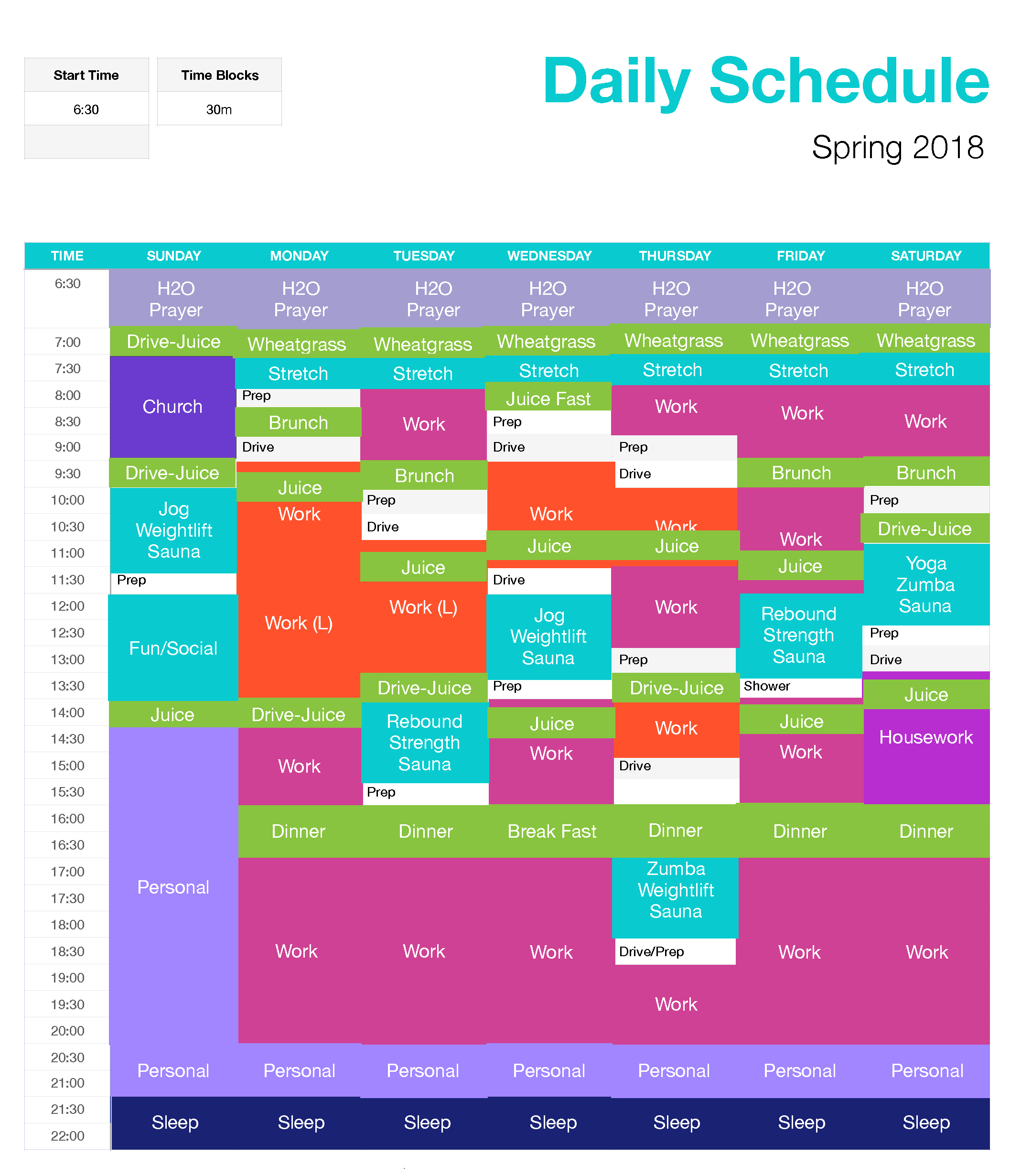Isn’t it funny how there are things that we know we should be doing for our health, yet we still don’t manage to do them? I frequently speak to my clients about their health goals and how they can achieve them. Often, the number one reason people fail to implement lifestyle changes is that they feel that they don’t have the time. While there may well be deeper reasons driving this all-too-common defense, the truth lies in your priorities. Perhaps you may feel that the time you spend at work to make a living is preventing you from devoting the time needed to focus on your health and wellbeing. We all know that there are 24 hours, or 1,440 minutes in a day, a third of which is usually spent asleep. The remaining hours are yours to spend as you determine. This equates to 16 hours or 960 minutes in a day.
With the beginning of this new year, as I was reflecting on my plans and goals, the value of time became evident. I realized that if I desired to embark upon my many plans in a successful manner, I had to visualize my day and account for the use of every minute. For those of you who know my story, having been in hospice with ovarian cancer and being told that I had 4 weeks to live highlighted the preciousness of time for me, like no other experience, for which I am most grateful. So, while I currently use an electronic calendar, I wanted to be able to better visualize the hours in my day to ensure that the ‘big rocks’—those things that are of highest priority, as described by Dr. Stephen R. Covey, in his book, “The Seven Habits of Highly Effective People: Powerful Lessons in Personal Change”—were on my calendar. Otherwise, it would be very easy for the smaller rocks—the lower priority items—to fill up my day in a way that would not be meaningful.
Because I had been literally on the brink of death, another truth revealed itself—without your health, all of your busyness, work, and activities is all for naught. Without health, your earnings can’t be enjoyed. Without health, you can’t fully enjoy the relationships of those closest to you. Without your health, all your material possessions are meaningless and irrelevant. That’s the reason why I place such a high priority on health. So, I decided to create a chart of a typical week to visualize each day in order to ensure that I could create a daily schedule that would provide the greatest chance for success.
It doesn’t matter what software application you use, even if you simply draw it out on a piece of paper. The importance is actually taking the time to identify what your priorities are so that that you can put them on the calendar because anything that you hope for and don’t put on your calendar is simply wishful thinking. Here’s what I came up with:
This may provide you with some insight into how you can incorporate wellness into your own daily schedule. Because every day for me is different, what follows, is a description of my schedule for a typical Tuesday. My hope is that you will be able to identify available timeslots in your schedule and make them work for you.
6:30 – 7:00 AM.
Hydrate with Water (H20) and Prayer. The best thing to do immediately upon awakening in the morning is to hydrate yourself, after not drinking any fluids for the 8 hours or so that you’ve slept. As our bodies are mostly made of water, we must replenish it because your body has actually been working throughout the night while you were sleeping. Water keeps your digestive system working properly, helps to flush out toxins, maintains or improves your skin’s moisture, and it allows your organs to function. Unfortunately, many people suffer from chronic illnesses that are the result of dehydration.
Drinking 16 ounces of warm water with lemon on an empty stomach is great for detoxifying your liver as well as jump starting your digestive juices. If you like, you can also add a drop of lemon essential oil, as d-limonene, a key constituent, has many health benefits like helping to break down cholesterol as well as having potent anti-cancer properties.
After consuming my lemon water, I spend time in prayer and reading the Bible. This is my opportunity to connect with God, pray for others, and seek guidance and wisdom for my daily activities. By allowing myself this time, my mind, body, and spirit can become aligned, providing more clarity in setting my intentions for the day.
I also use this time to journal and to set my goals for the day. By writing down my daily intentions, I find that my brain begins to activate both the conscious and subconscious, which enables the manifestation of these goals. Writing down and daily revisiting your goals will improve your chance and success of reaching these goals; and when you tie these goals to how you want to feel when you achieve these goals, this will actually activate parts of your brain to keep you motivated. That’s part of the reason why I created the Passion Journal, to help you get in touch with your passion and what brings you joy.
7:00 – 7:30 AM.
Wheatgrass. Wheatgrass juice is abundant in vitamins A, C, and E. It’s also rich in calcium, iron, magnesium, potassium, and chlorophyll. I learned early on in my journey of healing from ovarian cancer that this potent juice was very beneficial in providing my body with the nutrients to neutralize toxins, oxygenate the blood, and halt the growth of bacteria. Because wheatgrass is most beneficial when coming from a live source, I juice fresh wheatgrass every morning, drinking 2 ounces.
7:30 – 8:00 AM.
Stretch. After drinking wheatgrass juice, I go outside and stretch in the morning sunlight, which is so important for not only Vitamin D production in our bodies, but also melatonin, dopamine, and serotonin production, all very important for optimizing and regulating our circadian rhythm as we are part of all the living things on this earth that require energy from sunlight. During the warmer months, I’ll be on the grass in my bare feet as this helps to grounded the body to the Earth’s natural frequency, which is very healing. Doing this daily practice will help to improve your flexibility, blood circulation, range of motion, and will open up the flow of energy within your body.
As you may have read in my article, Start Your Morning Off Right, early sunlight exposure is also correlated with lower body mass index. Therefore, if one of your goals this year is to lose weight, consider getting outside to enjoy the sunrise.
9:30 AM – 1:30 PM
Work. This can be a number of different work activities, depending on the day, and for me, often consists of health coaching clients, researching and writing, speaking engagements, and interviews. Depending on the activity, at 9:30 AM, I’ll have a late breakfast or brunch. During warmer months, I may opt for berries, making a green smoothie, or having some raw, sprouted buckwheat. In the colder months, I may choose a sweet potato or even some lentil soup. After this, I resume working at 10:00 AM.
By about 11:15 am, while working, I will drink fresh green juices to sustain me. You can easily make these at home with a juicer, or, for convenience, if you can find organic, cold-pressed green juice shops that can save on time. If this is the case, it would be important to include sprouts in those juices as they have 10 to 30 times more vitamins, minerals, enzymes, and phytonutrients than the best organic produce that you can find. Later, in the afternoon, it would be good to drink another fresh wheatgrass juice. However, I also use a green barleygrass powder, which is handy when I’m away from home or traveling.
1:30 – 1:45 PM
Green Juice. I drink another 16 ounces of fresh green juice.
2:00 – 3:30 PM
Physical training. Most days, I work out for approximately 90 minutes. A typical workout for me is 30 minutes of jogging or rebounding, 30 minutes of weightlifting or strength training, and 30 minutes in the sauna.
4:00 – 5:00 PM.
Dinner. For dinner, I make a large green salad. During the winter months, I’ll include some warm soup, like lentil, vegetables, or some beans. My green salads normally consist of greens like arugula, dandelion, bok choy, asparagus, and watercress, as well as sprouts like sunflower sprouts, pea shoots, bean sprouts, alfalfa sprouts, and clover sprouts. For variation, I’ll also add red bell pepper, and I love fresh turmeric root, ginger root, and fresh garlic. however, I typically try to stay away from foods from the nightshade family. For a salad dressing, I’ll combine freshly squeezed lemon juice with garlic, olive oil, and basil. If I want a cheesy taste, I’ll combine ground walnuts with nutritional yeast. I also use dried sea vegetables which is a great source of iron, calcium, and iodine.
5:00 – 8:30 PM.
Back to work.
8:30 – 9:30 PM.
Personal time. Now it’s time to wind down and prepare for bed. This is the time that I turn off the computer, eliminating the artificial blue light that disrupts circadian rhythm. I will also turn off my wi-fi router to eliminate electromagnetic radiation as this is very harmful to the communication of the cells in your body and can disturb your sleep at night. In my article, The Invisible Fields Affecting Your Health, I wrote about how electromagnetic radiation has been proven to impact the melatonin production in your body. Low levels of melatonin have been linked to several diseases, including cancer.
After shutting down all of my electronic devices, I’ll wash up and relax by reading a book, so that I am ready to fall asleep.
9:30 PM – 6:30 AM.
Get some sleep. While you may find it challenging to get enough sleep, often due to work, or other obligations, the hours that you sleep are crucial for your overall health and cognitive function. During your hours of rest, your brain is processing information and cleansing to renew cells, while your body is repairing cells, and hormones are being released that affect your body’s growth, hunger levels, and how your body reacts to insulin when you begin to eat again.
If you’re not getting enough deep sleep, you may experience brain fog, your body will be fatigued, and your hunger will increase. If your sleep debt becomes too high, you may also find yourself falling asleep in the middle of the day. In general, the recommended amount of sleep is 7-8 hours, but some may need even as much as 10 hours.
Every day, we have the opportunity to choose how we will use our 1,440 minutes. Too often, we don’t take the time to include our health goals in our daily plans. By looking at your daily schedule and your priorities, you can determine what activities can be re-arranged so that you can accomplish your health goals. Your health is very important. Make it a priority by including it on your schedule.
Ready to make your health a priority? Contact me here to schedule your consultation.


